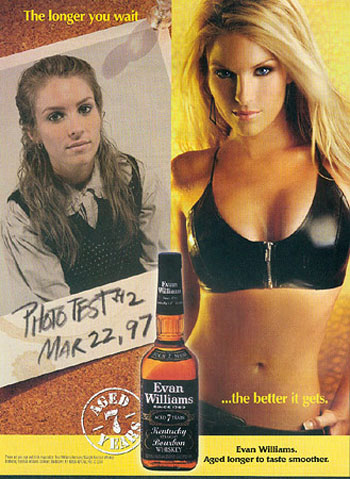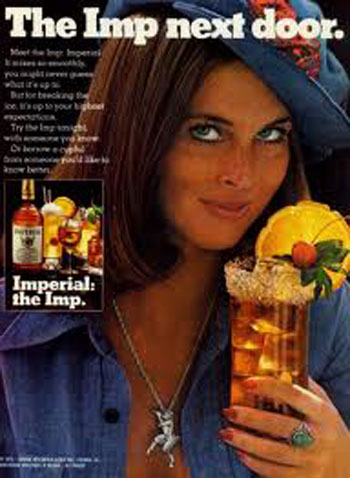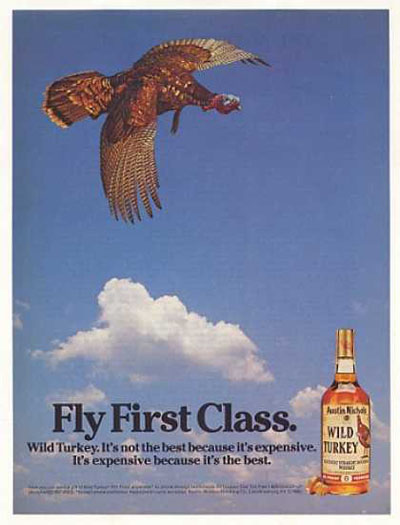
| Women and Class |
| In the Evan Williams advertisement the woman has a before and after picture. The girl is portrayed as a nerdy unattractive school girl on the left side and as you pan to the right there is a smoking hot blonde woman in a leather sports bra seductively looking at you. The left shows the given and the change that happens to this girl is through the transforming liquid called "Evan Williams". The caption reads "the longer you wait, the better it gets". This women that has magically transformed with age is the object of desire for many stereotypical heterosexual males. The longer this whiskey ages, as well as woman, the better it is. Smoother, great body, and aged are ways that the viewer can describe both the whiskey and the woman. Women have been seen in recent culture as the older the better when it comes to a sexual object. The bagging of a cougar in today's society is almost like the equivalent to a female gold-digger. This phenomena gives the perspective that even though the woman on the right is seen as the sexual object she is also in a position of power, such as a dominatrix. However, it could be seen the other way around. There is also a cultural bounty for older men to date or snag a younger women. A man older than the woman on the left shows that if he just waits till she gets out of school then he could be coming home to the bombshell on the right. An advertisement like this helps consumers buy into the myth that age is a factor and the more extreme the age difference, to a certain point, the better. Evan Williams portrays this well as they associate an attractive woman with their whiskey. The longer left to age the better. |

|

|
The Imperial Imp is the "Imp or (Girl) next door". Again this plays on a cultural sexual fantasy. Looking through these ads one can denote that these women are solely used as a way to prey on the men's subconscious. They are there to only be a temptresses. The Imp is a woman that described by Merriam-Webster dictionary as "small and mischievous". These words are used to belittle the woman giving a man the connotation that she can be dominated and at the same time her gaze allows her to be viewed as "naughty". The coy and seductive look is just as inviting as the drink she is holding. This whiskey is used to synonymously compare with the dominatrix woman, a female that will manipulate and tempt anyone to help achieve her desires. Woman are portrayed in these ads as a means to an end. As seen in these ads women are shown to provide a false sense of desire. Advertisers help objectify women in the ads in order to make the whiskey they are selling appear sexier, more appealing, and desirable. These women are pictured as having no other desires than you, the viewer. There are no aspirations or feelings associated with these women, only the ones the male gaze has, sex. Women through liquor ads have been shown predominately as the trophy one can get through the consumption of the product they are helping advertise. |


| The truth, by this frame, shows that the "Seagrams 7" is the safe and obvious choice in pleasing your guest, there is no risk involved. Seagrams is saying if you don't choose their safe option then you open yourself up for social embarrassment. On top of serving the wrong spirit at a cocktail party one needs to worry about how people are judging you as a person at the same time. It again interpellates the man that you are what you consume. Men have been interpellated through the myth that whiskey is a mans drink. Whiskey has been building a myth that it obtains all values that a male wants in order to seem masculine and through that there is no other alternative spirit for men to consume. Whiskey as we have seen provides women, class, masculinity when drank a particular way, and power. Seagrams 7 will give you power. This ad portrays that with serving this whiskey you will be viewed as a great host giving you power over your peers. Seagrams will give you the freedom to be who you want and at the same time it controls your audience so they will be satisfied with what you are serving them. |

|

|
"Wild Turkey" shows that with the consumption of their whiskey you will be flying first class. First class flying is culturally framed as the person that is flying first class is a businessman, important, and has the extra funds to indulge on a little more leg room and special pampering by the flight attendants. "Wild Turkey" is trying to anchor their brand with an already culturally coveted position. The words read "Fly First Class. It's not the best because it's expensive. It's expensive because it's the best." This can be compared and anchored by the idea of first class. One does not simply fly first class because it is expensive but because it is a luxury for the best and therefore associating with this ideology shows that a person is classy enough to be able to drink the whiskey that made this connection possible, Wild Turkey. Buying an expensive whiskey gives you the persona that you understand what the best is. You as the consumer have an eye for what will provide you with the best experience and can give you the feeling of an expensive lifestyle. |
|
|
Navarro-Beltra, Marian, and Marta Martin Llaguno "A Systematic Review Of Gender And Advertising Studies." Catalan Journal Of Communication Cultural studies 4.2 (2012): 171-183. Communication & mass media complete. Web. 8 May 2013.
Waade, Anne Marit. "Imagine paradise In Ads: Imagination And Visual Matrices In Tourism And Consumer Culture." Nordicom Review 311 (2010): 15-33. Communication & Mass Media Complete. Web. 7 May 2013
Webster, Noah, William Allan Neilson, Thomas A. Knott, and Paul W. Carhart.Webster's New International Dictionary of the English Language. Springfield, MA: G. & C. Merriam, 1941. Print.